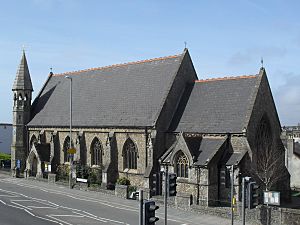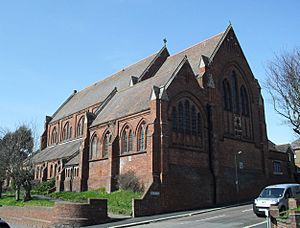Christ Church, Ore facts for kids
Quick facts for kids Christ Church |
|
|---|---|

The church from the east
|
|
| 50°52′20″N 0°36′30″E / 50.8722°N 0.6082°E | |
| OS grid reference | TQ 83612 11315 |
| Location | Old London Road, Ore, Hastings, East Sussex |
| Country | England |
| Denomination | Church of England |
| Churchmanship | Open Evangelical |
| Website | http://www.christchurch-ore.org.uk |
| History | |
| Status | Parish church |
| Founded | 23 November 1858 |
| Founder(s) | Rev. W. T. Turner |
| Dedication | Christ Church |
| Dedicated | 1858 |
| Architecture | |
| Functional status | Active |
| Heritage designation | Grade II |
| Designated | 14 September 1976 |
| Architect(s) | Alexander Dick Gough |
| Style | Decorated Gothic |
| Completed | 1859 |
| Construction cost | £4,268 (£315,400 in 2021) |
| Administration | |
| Parish | Ore: Christ Church |
| Deanery | Rural Deanery of Hastings |
| Archdeaconry | Lewes and Hastings |
| Diocese | Chichester |
| Province | Canterbury |
Christ Church is an Anglican church located in the Ore area of Hastings, a town in East Sussex, England. It is one of three churches in Hastings with the name Christ Church. This church was built in 1858 in the Decorated Gothic style. It was created to serve the growing community of Ore, which was becoming part of the larger town.
A special part of the church is its tall, thin corner tower, called a bell turret. Some experts have called this tower "outstanding" and even "very naughty" because of its unusual design. The building is considered important for its history and architecture. It has been given a Grade II listing by English Heritage, which means it is a nationally important building.
Contents
The Church's Story
Hastings was once an old fishing town and a "Cinque Port" (a special group of coastal towns). In the 1800s, it became a popular seaside resort. This happened because new railway lines from London made it easier for people to visit. The town's population grew a lot, from about 11,000 to 23,000 people in just 20 years.
As Hastings grew, it spread inland. The small village of Ore, located on the road to Rye, slowly became part of the town. Ore was first mentioned in the early 1100s. Its name comes from an old Anglo-Saxon word meaning "ridge" or "slope." An older church, St Helen's, was built in Ore in the 1100s. However, by the mid-1800s, St Helen's was far from where most people lived in Ore. It was also small and falling apart.
The local church leader, Reverend W.T. Turner, decided to build a new church closer to the people. Ore had become a poorer area with many people out of work. Reverend Turner wanted to offer more spiritual help to the growing community.
Building the New Church
Alexander Dick Gough, an architect and engineer, was chosen to design the new church. Gough was known for his unique and sometimes unusual Gothic designs. Christ Church was the only building he designed in Sussex. He submitted his plans in 1858, and the church was built over the next year. It cost £4,268, which was a lot of money back then.
A kind local helper named Countess Waldegrave laid the first stone on November 23, 1858. At first, Christ Church was a "chapel of ease". This meant it was a smaller church that helped the main parish church, St Helen's.
Changes Over Time
The church roof originally had special vents to let out smoke from its gas lights. These vents have since been removed. In the early 1900s, a beautifully carved wooden screen, called a reredos, was added inside the church.
After World War I, a memorial was placed near the church entrance. Later, a part of the church called the north transept was changed into a vestry (a room for clergy and church items). This new vestry became a memorial for those who died in World War II. The church itself was damaged by bombs in February 1943 but was quickly repaired.
The unique corner tower was fully repaired in 2003. Work was done on its clock, bell, spire, and the weather vane on top.
Church Design and Features
Christ Church is a special and well-preserved example of a Gothic Revival church. It is built in the Decorated Gothic style. The main materials used are sandstone and Kentish ragstone, which are types of stone. The roof is covered with slate tiles.
The "Naughty" Turret
The most striking part of the outside is the tall, thin, eight-sided tower. It has a clock face, holds a bell, and is topped with a spire and a weather vane. A famous architectural expert, Nikolaus Pevsner, playfully called this Victorian design "very naughty" because it was so unusual.
The church's layout includes a chancel (the area around the altar), a nave (the main part where people sit), and an aisle on the north side. It also has an organ room, two vestries (one used to be a transept), and two entrance porches. The outside of the church has strong stone supports called buttresses all around. The church is built facing north-south, which is different from the usual east-west direction for churches.
Inside the Church
The windows are all tall, narrow "lancets" with detailed stone patterns called tracery. The large window at the west end has seven sections, and the east window is similar. Beautiful stained glass was added to two windows in 1930.
Inside, you can see amazing carvings of plants and leaves. These are especially detailed on the tops of the columns (called capitals) in the nave and on the stone supports (called corbels). There are also painted designs above the chancel arch and the east window. These designs were refreshed in the early 1990s.
Other things inside the church include three sedilia (seats for clergy), a wooden pulpit (where sermons are given), a simple eight-sided font (used for baptisms), and a wooden reredos (a screen behind the altar). This reredos has tablets showing the Ten Commandments, the Lord's Prayer, and the Nicene Creed.
Christ Church Today

Christ Church was officially listed as a Grade II building by English Heritage on September 14, 1976. This means it is a "nationally important" building with "special interest." In 2001, it was one of many listed buildings in Hastings.
Christ Church in Ore is the oldest of three active Anglican churches in Hastings named "Christ Church." The other two are in Blacklands (built 1878–81) and on London Road in St Leonards-on-Sea (built 1875).
The area that Christ Church serves, called its parish, includes parts of Ore east of the railway line. It stretches north and east to the town's edge and south to Frederick, Mount, and Edwin Roads. This parish now also includes the area that used to be served by All Souls Church, Hastings, which closed in 2007.
On Sundays, there is a church service at 10:30 AM, which includes a Kids group. Shorter daily prayer services are held on weekday mornings. On Wednesday mornings, there is a special Eucharistic service using the Book of Common Prayer.
See also

